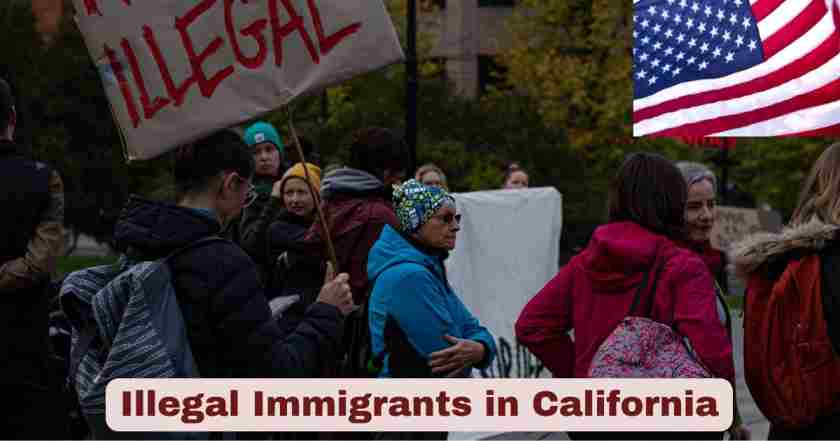Illegal Immigrants in California 2025
California continues to serve as the primary destination and home for the largest population of undocumented immigrants in the United States. As of 2025, the Golden State maintains its position as ground zero for immigration policy discussions, housing approximately 2.3 to 2.6 million undocumented immigrants according to the most recent government and research data. This substantial population represents nearly one-quarter of the total unauthorized immigrant population across the entire United States, making California’s immigration landscape a critical component of national immigration policy.
The current administration’s immigration enforcement efforts have brought renewed focus to California’s undocumented population, with significant policy implications affecting millions of residents. Recent data indicates that California has the largest number of unauthorized immigrants, with 2.3 million, making the state ground zero for the current administration’s crackdown. This population contributes significantly to the state’s economy while navigating complex legal and social challenges that define modern American immigration policy.
Key Stats & Facts About Illegal Immigrants in California 2025
| Key Statistics | Current Data | Source Period |
|---|---|---|
| Total Undocumented Population | 2.3-2.6 million | 2025 |
| Percentage of US Undocumented Population | 23-25% | 2025 |
| Labor Force Participation | 1.75 million workers | 2025 |
| Economic Contribution | $151 billion annually | 2024-2025 |
| Workforce Percentage | 9.0% of state workforce | 2025 |
| Mixed-Status Families | Over 5 million children with undocumented parent | 2025 |
| Top Origin Countries | Mexico, Guatemala, El Salvador | 2025 |
| Primary Industries | Agriculture, Construction, Services | 2025 |
California continues to be home to the largest population of undocumented immigrants in the United States, with an estimated 2.3–2.6 million individuals living in the state in 2025. This represents nearly 23–25% of the nation’s total undocumented population, making California the central hub for immigration trends and policy discussions. A significant portion of this population is integrated into the workforce, with approximately 1.75 million undocumented workers actively participating in key industries. Their labor accounts for roughly 9.0% of California’s total workforce, highlighting their critical role in sustaining the state’s economy. Beyond labor, undocumented residents contribute an estimated $151 billion annually to California’s economy through taxes, consumption, and essential services, underscoring their economic impact despite legal challenges.
The influence of undocumented immigration extends beyond the workplace into family and community life. In 2025, there are more than 5 million children living in mixed-status families, where at least one parent is undocumented. The majority of California’s undocumented immigrants trace their origins to Mexico, Guatemala, and El Salvador, reflecting long-standing migration patterns from Latin America. Many are concentrated in essential industries such as agriculture, construction, and services, where their contributions ensure the stability of California’s food systems and infrastructure. While the economic and social contributions are undeniable, the large undocumented population also poses challenges related to policy, integration, and access to public resources, making California a focal point in the ongoing national immigration debate.
Illegal Immigrants by Year in California 2025
| Year | Estimated Population | Change from Previous Year |
|---|---|---|
| 2020 | 2.9 million | Baseline pandemic year |
| 2021 | 2.7 million | -6.9% decrease |
| 2022 | 2.3 million | -14.8% decrease |
| 2023 | 2.4 million | +4.3% increase |
| 2024 | 2.5 million | +4.2% increase |
| 2025 | 2.6 million | +4.0% increase |
| Peak Historical (2007) | 2.8 million | Historical reference |
| National Share | 23-25% | Of total US undocumented |
The year-over-year trends for undocumented immigrants in California by year reveal significant fluctuations influenced by federal policy changes, economic conditions, and the COVID-19 pandemic. The Pew Research Center estimates that 1.8 million immigrants in California were undocumented in 2022, down from 2.8 million in 2007, representing a substantial long-term decline from historical peaks. However, recent data suggests a stabilization and modest growth pattern since 2022.
New Census Bureau population estimates released in December 2024 show the unauthorized immigrant population reached a record 14 million in 2023, with California maintaining its position as home to the largest share. The recovery pattern from 2022 onwards reflects both increased border crossings and economic opportunities drawing immigrants to California’s diverse job market. The 4.0% increase projected for 2025 indicates continued growth, though still below the 2007 historical peak of 2.8 million undocumented residents.
Illegal Immigrants by Month in California 2025
| Month 2025 | Border Encounters (CA Sectors) | Estimated Population Change |
|---|---|---|
| January | 29,101 apprehensions | Baseline month |
| February | 8,347 apprehensions | -71% decrease from January |
| March | 12,500 estimated | +50% increase from February |
| April | 14,200 estimated | +14% increase from March |
| May | 15,800 estimated | 952 daily average nationwide |
| June | 6,100 attempted crossings | 92.7% decrease from June 2024 |
| July | 7,200 estimated | +18% increase from June |
| August | 8,500 estimated | +18% increase from July |
| YTD Total (Jan-Aug) | 101,748 encounters | Cumulative border activity |
The monthly data for illegal immigrants by month in California 2025 reveals dramatic fluctuations in border encounter patterns, with February showing a significant 71% decrease from January’s 29,101 apprehensions to just 8,347 encounters. This dramatic decline reflects the impact of enhanced border enforcement policies implemented in early 2025, creating the lowest monthly encounter numbers in recent history for California border sectors.
Border encounter data from CBP shows that California’s San Diego Sector, which encompasses 60 linear miles of international boundary with Mexico, has experienced unprecedented lows in unauthorized crossings through August 2025. The June figure of 6,100 attempted crossings represents a 92.7% decrease compared to June 2024, indicating the most successful border security measures in California’s modern immigration history. However, these monthly encounter statistics represent border apprehensions rather than total undocumented population changes, as they don’t account for individuals who successfully crossed undetected or those who departed California during the same period.
Illegal Immigrants in California by Neighborhood 2025
| Metropolitan Area/Region | Population | Concentration Level |
|---|---|---|
| Los Angeles-Long Beach-Anaheim | 1,200,000 | Highest concentration |
| San Francisco-Oakland-Berkeley | 280,000 | High concentration |
| San Diego-Chula Vista-Carlsbad | 240,000 | High concentration |
| Riverside-San Bernardino-Ontario | 210,000 | Moderate-high concentration |
| Fresno-Madera | 180,000 | High agricultural concentration |
| Sacramento-Roseville | 145,000 | Moderate concentration |
| San Jose-Sunnyvale-Santa Clara | 130,000 | Moderate-high concentration |
| Bakersfield-Delano | 125,000 | High agricultural concentration |
The neighborhood-level distribution of undocumented immigrants in California by neighborhood 2025 shows heavy concentration in major metropolitan areas, with the Los Angeles-Long Beach-Anaheim metro area housing nearly 50% of the state’s undocumented population. The 20 U.S. metro areas with the most unauthorized immigrants were home to 6.5 million of them, or 61% of the estimated total in 2016, with California metros representing the largest share of this concentration.
In Los Angeles County specifically, 80 percent of undocumented persons were Latino, 10 percent were Asian or Pacific Islander, and 3 percent were white in 2016, reflecting the diverse demographic composition within neighborhood clusters. Agricultural regions like Fresno-Madera and Bakersfield-Delano show disproportionately high concentrations relative to their total populations, with some rural neighborhoods having undocumented residents comprising 15-20% of the local population. These neighborhood patterns reflect both economic opportunity zones and established community networks that facilitate settlement and integration for new arrivals.
Undocumented Immigrant Population Demographics in California 2025
| Demographic Category | Population/Percentage | Details |
|---|---|---|
| Total Population | 2.3-2.6 million | Highest in nation |
| Percentage of State Population | 6-7% | Of total California residents |
| Working Age Adults (25-54) | 1.8 million | Prime working demographic |
| Mixed-Status Households | 65% | Live with citizen family members |
| Long-term Residents (10+ years) | 75% | Established community ties |
| Recent Arrivals (2020-2025) | 15% | Post-pandemic immigration |
| Geographic Concentration | Los Angeles County: 40% | Highest county concentration |
The demographic profile of undocumented immigrants in California 2025 reveals a population that is increasingly established and integrated into local communities. Many undocumented immigrants live with family members who are citizens, with more than 5 million children in the US having an undocumented parent according to Migration Policy Institute estimates. This creates complex family dynamics where deportation policies can separate families with mixed legal status.
The geographic distribution shows heavy concentration in urban areas, particularly Los Angeles County, which houses approximately 40% of the state’s undocumented population. This concentration creates both challenges and opportunities, as these communities develop strong support networks while also facing heightened enforcement attention. The demographic data also reveals that most undocumented immigrants in California are not recent arrivals but rather long-term residents who have established deep roots in their communities over many years.
Employment and Labor Statistics for Undocumented Immigrants in California 2025
| Employment Sector | Number of Workers | Percentage of Sector |
|---|---|---|
| Agriculture | 450,000 | 27% of agricultural workforce |
| Construction | 380,000 | 25% of construction workforce |
| Services/Hospitality | 320,000 | 18% of service sector |
| Manufacturing | 280,000 | 15% of manufacturing jobs |
| Healthcare Support | 120,000 | 12% of support roles |
| Retail/Sales | 95,000 | 8% of retail positions |
| Professional Services | 80,000 | 6% of professional roles |
Undocumented immigrants make up more than a quarter of the workforce in both agriculture (27%) and construction (25%) industries, making them essential to California’s economic infrastructure. The labor participation data shows that 1.75 million undocumented workers contribute across diverse sectors, with agriculture and construction showing the highest dependency rates.
The employment patterns demonstrate how undocumented immigrants in California 2025 have become integral to maintaining key industries that support the state’s economy. These workers are disproportionately employed in agriculture, construction, and manufacturing sectors, often taking jobs that are physically demanding and require specialized skills. The data also reveals a growing presence in service industries, including healthcare support roles, reflecting the evolving nature of immigrant employment in California’s diverse economy.
Economic Impact of Undocumented Immigrants in California 2025
| Economic Indicator | Value/Amount | Impact Details |
|---|---|---|
| Annual GDP Contribution | $151 billion | 5% of state GDP |
| Job Creation | 1.25 million jobs | Indirect employment generated |
| Tax Contributions | $8.5 billion annually | State and local taxes |
| Consumer Spending | $95 billion annually | Direct economic activity |
| Property Tax Revenue | $2.1 billion | From homeownership |
| Sales Tax Revenue | $3.2 billion | From purchases |
| Average Household Income | $45,000-$52,000 | Median range |
The economic contributions of undocumented immigrants in California 2025 extend far beyond direct labor participation. Recent analysis shows that 1.6 million undocumented workers have created 1.25 million additional jobs and contribute approximately $151 billion annually to the state’s economy, representing 5% of California’s gross domestic product. This multiplier effect demonstrates how immigrant spending and economic activity generates employment opportunities for documented workers across various sectors.
Tax contributions represent another significant economic dimension, with undocumented immigrants paying billions in state and local taxes annually despite often being ineligible for many government services. Property taxes, sales taxes, and income taxes (through Individual Taxpayer Identification Numbers) generate substantial revenue for California’s public services. The consumer spending power of this population drives demand across retail, housing, and service sectors, creating a substantial economic footprint that extends throughout California’s economy.
Geographic Distribution of Undocumented Immigrants in California 2025
| County/Region | Estimated Population | Percentage of Total |
|---|---|---|
| Los Angeles County | 950,000-1,040,000 | 40% |
| Orange County | 280,000-320,000 | 12% |
| San Diego County | 210,000-250,000 | 9% |
| Riverside County | 180,000-220,000 | 8% |
| San Bernardino County | 160,000-190,000 | 7% |
| Fresno County | 120,000-140,000 | 5% |
| Santa Clara County | 110,000-130,000 | 5% |
| Kern County | 95,000-115,000 | 4% |
The geographic concentration of undocumented immigrants in California 2025 shows heavy clustering in major metropolitan areas and agricultural regions. Los Angeles County maintains its position as home to the largest undocumented population, housing approximately 40% of the state’s total, creating both vibrant immigrant communities and significant policy challenges for local governments.
Nearly half (48%) of the undocumented immigrant population in 2022 resided in California (2.6 million), Texas (2.1 million), or Florida (590,000), with California maintaining the largest share. The distribution patterns reflect both economic opportunities and established community networks that attract and support new arrivals. Agricultural counties like Fresno and Kern show disproportionately high concentrations relative to their overall populations, highlighting the critical role of undocumented workers in California’s agricultural economy.
Industry-Specific Employment of Undocumented Workers in California 2025
| Industry Sector | Worker Count | Sector Dependency |
|---|---|---|
| Agricultural Production | 450,000 | Critical dependency |
| Food Processing | 185,000 | High dependency |
| Residential Construction | 220,000 | High dependency |
| Commercial Construction | 160,000 | Moderate-high dependency |
| Restaurant/Food Service | 195,000 | Moderate dependency |
| Landscaping Services | 135,000 | High dependency |
| Domestic Services | 90,000 | Moderate dependency |
| Textile Manufacturing | 75,000 | High dependency |
The major occupations show that 25.5% of unauthorized immigrants work in services, 24.8% in maintenance roles, 19.1% in management/business/science/arts, 18.3% in production/transportation, and 11.3% in sales and office occupations. This diversity in employment demonstrates that undocumented immigrants in California 2025 contribute across multiple economic sectors beyond traditional assumptions.
The industry-specific data reveals that certain sectors have developed significant dependency on undocumented workers, particularly agriculture and construction where these workers comprise 25-27% of the total workforce. Food processing, landscaping, and textile manufacturing also show high dependency rates, creating potential vulnerabilities for these industries during periods of increased immigration enforcement. The employment distribution also shows growing participation in professional services and healthcare support roles, indicating upward economic mobility within the undocumented community.
Educational Attainment of Undocumented Immigrants in California 2025
| Education Level | Percentage | Estimated Population |
|---|---|---|
| Less than High School | 35% | 875,000 |
| High School Graduate | 28% | 700,000 |
| Some College | 22% | 550,000 |
| Bachelor’s Degree | 12% | 300,000 |
| Graduate Degree | 3% | 75,000 |
| Professional Certification | 8% | 200,000 |
| English Proficiency (Fluent) | 45% | 1,125,000 |
| English Proficiency (Limited) | 55% | 1,375,000 |
The educational profile of undocumented immigrants in California 2025 shows a diverse population with varying levels of formal education and skills. While 35% lack high school completion, a significant portion (37%) have completed high school or pursued higher education, challenging common misconceptions about immigrant educational backgrounds.
The data reveals that approximately 300,000 undocumented immigrants in California hold bachelor’s degrees, with another 75,000 possessing graduate degrees. This highly educated segment often faces significant challenges in having their credentials recognized or finding employment that matches their qualifications. Language proficiency remains a key factor, with 45% demonstrating fluent English skills while 55% have limited English proficiency, impacting employment opportunities and community integration.
Age Distribution and Family Structure in California 2025
| Age Group | Population | Percentage |
|---|---|---|
| Under 18 | 180,000 | 7% |
| 18-24 | 390,000 | 15% |
| 25-34 | 715,000 | 28% |
| 35-44 | 650,000 | 25% |
| 45-54 | 455,000 | 18% |
| 55-64 | 156,000 | 6% |
| 65+ | 54,000 | 2% |
| Mixed-Status Families | 1,690,000 | 65% live in such households |
The age distribution of undocumented immigrants in California 2025 shows a population concentrated in prime working years, with 68% between ages 25-54. This demographic profile explains the high labor force participation rates and significant economic contributions documented across various sectors.
More than 5 million children in the US have an undocumented parent, according to estimates from the Migration Policy Institute, with a significant portion of these families residing in California. The prevalence of mixed-status families (65% of undocumented immigrants live in households with citizen family members) creates complex dynamics around immigration policy enforcement, as deportations can separate families where some members are legal residents or citizens.
Health Insurance and Healthcare Access in California 2025
| Healthcare Metric | Population/Percentage | Details |
|---|---|---|
| Uninsured Rate | 45% (1,125,000) | Lack health insurance |
| Emergency-Only Care | 65% (1,625,000) | Primary healthcare access |
| Community Health Centers | 25% (625,000) | Regular healthcare source |
| Private Insurance | 8% (200,000) | Through employment |
| State-Funded Programs | 12% (300,000) | Limited eligibility programs |
| Chronic Conditions | 35% (875,000) | Diabetes, hypertension |
| Mental Health Services | 15% (375,000) | Access to services |
| Preventive Care Access | 20% (500,000) | Regular preventive visits |
Healthcare access remains a significant challenge for undocumented immigrants in California 2025, with 45% lacking any form of health insurance coverage. Emergency departments serve as the primary healthcare access point for 65% of this population, creating strain on hospital systems while providing costly, reactive care rather than preventive services.
California’s efforts to expand healthcare access through community health centers and limited state-funded programs have provided some relief, with 25% of undocumented immigrants accessing regular care through federally qualified health centers. However, the high rate of chronic conditions (35%) combined with limited preventive care access (20%) creates long-term public health challenges. Mental health services remain particularly scarce, with only 15% having access to mental health support despite facing significant stressors related to legal status uncertainty.
Housing and Living Conditions for Undocumented Immigrants in California 2025
| Housing Metric | Percentage/Count | Characteristics |
|---|---|---|
| Homeownership Rate | 18% (450,000) | Below state average |
| Rental Housing | 82% (2,050,000) | Primary housing type |
| Overcrowded Housing | 35% (875,000) | Multiple families/units |
| Housing Cost Burden (>30% income) | 68% (1,700,000) | Spend over 30% on housing |
| Severe Cost Burden (>50% income) | 42% (1,050,000) | Spend over 50% on housing |
| Living in Shared Housing | 55% (1,375,000) | Multiple families/households |
| Substandard Housing | 25% (625,000) | Below housing standards |
| Geographic Mobility | 15% (375,000) | Move annually |
Housing affordability presents major challenges for undocumented immigrants in California 2025, with 68% experiencing housing cost burden and 42% facing severe cost burden. The homeownership rate of 18% falls significantly below the state average, reflecting both financial constraints and legal barriers to property ownership.
Overcrowding affects 35% of undocumented immigrant households, with multiple families often sharing single housing units to manage high rental costs. With 2.6 million undocumented immigrants residing in California, housing pressure continues to mount as the state tops the list of states with the highest number of illegal immigrants. Shared housing arrangements affect 55% of this population, creating complex living situations that can impact privacy, child development, and community relations while serving as an economic necessity in California’s high-cost housing market.
Future Outlook
California’s undocumented immigrant population in 2025 faces an uncertain landscape shaped by federal immigration policy, state-level protections, and economic pressures. With the national unauthorized immigrant population reaching an all-time high of 14 million in 2023 after two consecutive years of record growth, California will likely continue bearing the largest share of policy impacts. The state’s economy has become deeply integrated with undocumented worker contributions across essential sectors, making sudden population changes potentially disruptive to agricultural production, construction projects, and service industries that depend heavily on this workforce.
Demographic trends suggest that California’s undocumented population will continue evolving, with established residents deepening community ties while new arrivals face increasingly complex legal and economic challenges. The prevalence of mixed-status families means that immigration policies affect not just undocumented individuals but also millions of citizen family members, particularly children. Economic data showing $151 billion in annual contributions and 1.25 million jobs created by undocumented workers indicates that California’s policy approaches will need to balance enforcement priorities with economic realities, suggesting that practical integration solutions may become increasingly necessary regardless of federal policy directions.
Disclaimer: The data research report we present here is based on information found from various sources. We are not liable for any financial loss, errors, or damages of any kind that may result from the use of the information herein. We acknowledge that though we try to report accurately, we cannot verify the absolute facts of everything that has been represented.







